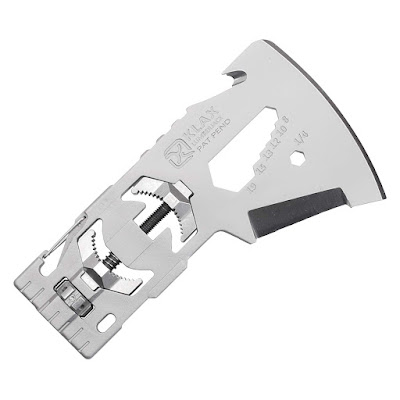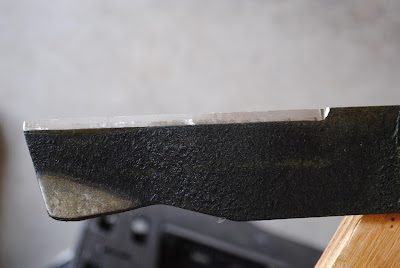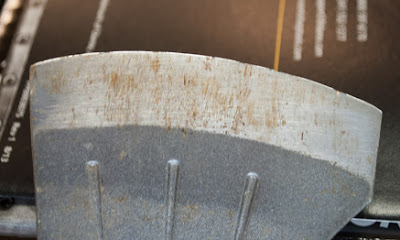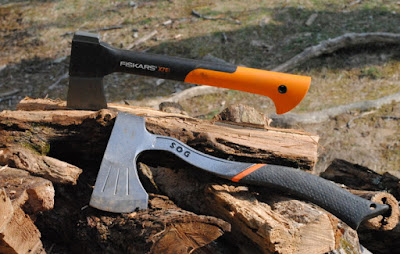The 2014 Warther Memorial Knife Show is over. It was held at Breitenbach Winery in the
lovely Breitenbach Tool Shed.
 |
| The Tool Shed |
I couldn’t squeeze the show in as a vendor, but I did drop
in on Sunday. I had several interesting
conversations and found a few things I couldn’t live without.
If you work with ivory, collect ivory and even own ivory you
should be concerned about President Obama’s Executive Order banning ivory.
No, I’m not anti-elephant.
African elephant ivory has been prohibited from import since the early
80s. Most of the illegal ivory trade is
currently driven by the Far East and laws controlling this practice aren’t
enforced by their governments.
This Executive Order bans ivory from animals killed before the ban. Oh, you can sell pre-ban, if you have the
paperwork proving it’s pre-ban. You
saved that bill of sale from the 80s, didn’t you?
There’s exceptions for fossil ivory, mastodon
ivory, walrus and others, but the responsibility is on you to prove it as well
as documentation of the port it entered the country. You got that as well, right? And forget about DNA. No matter what you saw on CSI, ivory has no
DNA.
The scariest part of this is the adoption of assumed guilt
until proven innocent. The enforcement
agent can simply suspect you’re guilty and seize your property and arrest
you. You then have to prove your
innocence. That’s just plain wrong.
I see this as just another step demonstrating the government’s
drive to neuter our rights. Today it's
ivory, tomorrow it might be guns, then books and the realization you live at
the pleasure of the government.
Enough politics, but I’ve got to say, I’m glad I’m old.
Did I find any treasures at the show?
 |
| The Shed is also used to store wine. |
I picked up a hatchet from Mickey Yurco. It’s a small hatchet just over 7 inches long
with an OD green and black striped micarta handle. The blade is curved and sub-three inches in
length and made from 440C steel.
 |
| It's small, but it's aimed at the emergency bug-out bag. |
440C is
the best of the 440 steel series and represents a middle grade of steel in the
knife community. It’s a good steel, rust
resistant, durable and can be resharpened without special equipment. It’s a good choice for a bug-out bag which is
what Mickey had in mind. One thing to
remember, 440C is magnetic and will affect compass readings. Just a word to the wise.
The hatchet comes with a Kydex sheath. I like Kydex for its durability, but this
sheath is a little hard to remove.
 |
| The cover fits tight, not a bad thing, but I have to jerk it out of the the sheath, so don't stand too close! |
Maybe
a summer Kydex sheath making project will solve my problem.
I also picked up an older doctor’s knife made for W. Bingham
Co in Cleveland Ohio. The knife was, my
internet search tells me, made by Ulster Knife Company. That may explain why both the main and
secondary blade are stamped.
I admit it took me a while to convince myself it was a doctor’s
knife. It’s doesn’t have the spatula and
the handle has an offset more typical of a gun stock pattern. Still the blade shape and the pill crusher
end convinced me.
 |
| The handle is more of a black with dark green highlights. Do you see the little curve in the handle? |
The handle has a faded green and black motif to it, so it
must have the effect of nice weather and grassy fields that had me thinking
about green and black.
Both the hatchet and knife are sweet!
How was the show?
I’m told Saturday had 280 attendees. I left around 1pm on Sunday. It was pretty bleak then but several vendors
reported that while the count was down, sales were strong.
Even though my wife and I had driven to the winery earlier in
the year, we still had trouble finding it.
The signage was poor and as you drove up the empty, winding gravel road you
got the feeling as one retired LEO suggested, you were being set up for a robbery
and car-jacking.
Tucked away in Dover, the knife show was a destination. Most of the Amish community is shut down on Sunday
and Dover was no exception. The winery
was closed and if you were looking for a restaurant, well you better head to Canton Ohio.
If you didn’t know about the show you wouldn't see anything to
suggest it existed. Nothing could
be seen on Interstate-77, so the show didn’t have any impulse attendees.
I will say, if WRCA doesn’t do something, I predict
there will be no Dale Warther Memorial Knife show in less than ten years.



















